ACCT20075 Auditing & Ethics: AIZ Limited Financial Analysis 2017
VerifiedAdded on 2023/06/08
|11
|2640
|500
Report
AI Summary
This report presents an analytical review of Air New Zealand (AIZ) Limited's 2017 annual auditor report, focusing on materiality in auditing, analytical review of the income statement and balance sheet from 2014-2017, audit procedures, and the formation of an opinion. It assesses materiality based on quantitative and qualitative factors, analyzes trends and risk areas, and reviews cash flows. The report identifies key management assertions, outlines audit procedures for various financial statement components, and evaluates the company's going concern risk. The auditor's unqualified opinion on the financial statements is also discussed, referencing New Zealand and international financial reporting standards. The analysis indicates potential concerns regarding cash outflows and the company's future financial stability.

Running head: AUDITING AND ETHICS 1
Auditing and Ethic
Name
Institutional Affiliation
Auditing and Ethic
Name
Institutional Affiliation
Paraphrase This Document
Need a fresh take? Get an instant paraphrase of this document with our AI Paraphraser
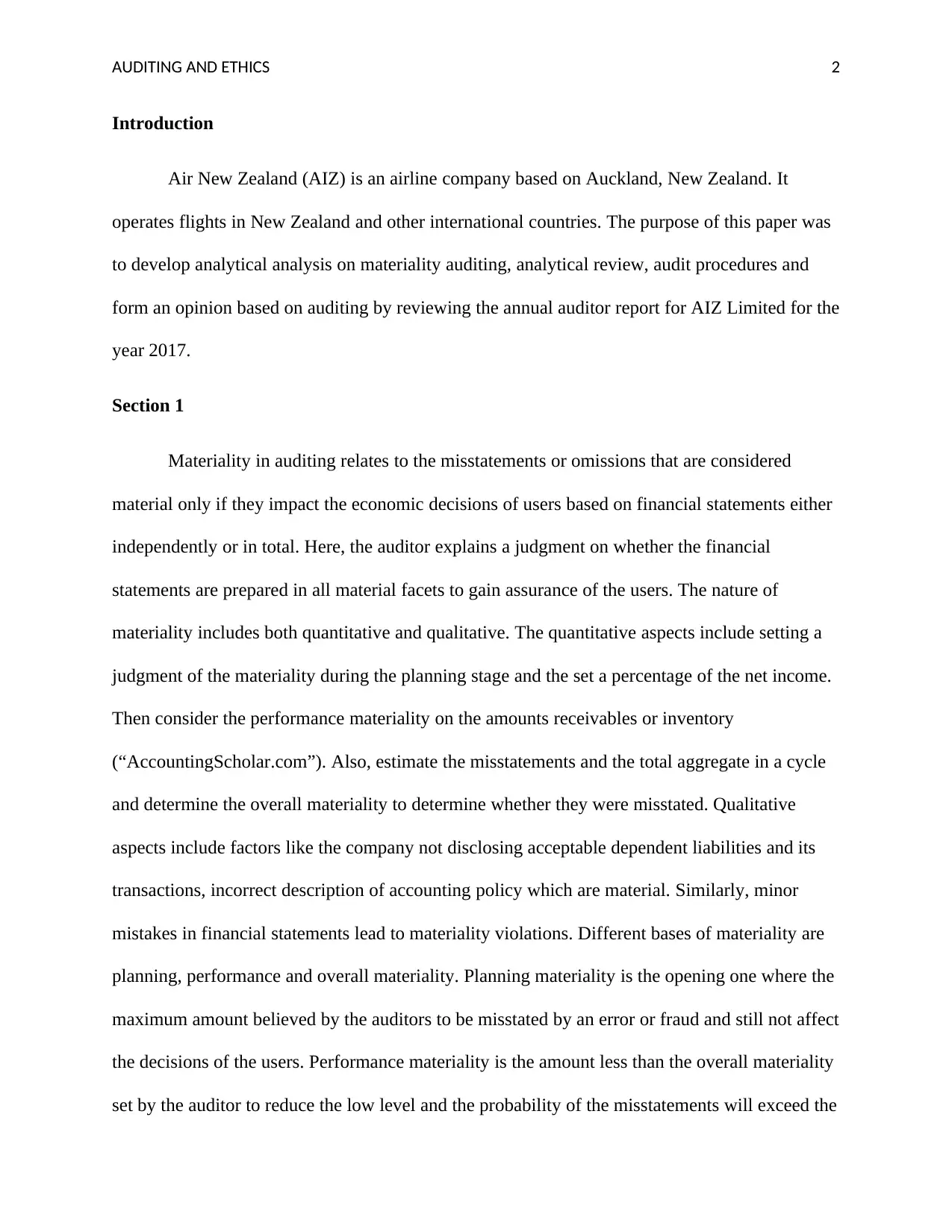
AUDITING AND ETHICS 2
Introduction
Air New Zealand (AIZ) is an airline company based on Auckland, New Zealand. It
operates flights in New Zealand and other international countries. The purpose of this paper was
to develop analytical analysis on materiality auditing, analytical review, audit procedures and
form an opinion based on auditing by reviewing the annual auditor report for AIZ Limited for the
year 2017.
Section 1
Materiality in auditing relates to the misstatements or omissions that are considered
material only if they impact the economic decisions of users based on financial statements either
independently or in total. Here, the auditor explains a judgment on whether the financial
statements are prepared in all material facets to gain assurance of the users. The nature of
materiality includes both quantitative and qualitative. The quantitative aspects include setting a
judgment of the materiality during the planning stage and the set a percentage of the net income.
Then consider the performance materiality on the amounts receivables or inventory
(“AccountingScholar.com”). Also, estimate the misstatements and the total aggregate in a cycle
and determine the overall materiality to determine whether they were misstated. Qualitative
aspects include factors like the company not disclosing acceptable dependent liabilities and its
transactions, incorrect description of accounting policy which are material. Similarly, minor
mistakes in financial statements lead to materiality violations. Different bases of materiality are
planning, performance and overall materiality. Planning materiality is the opening one where the
maximum amount believed by the auditors to be misstated by an error or fraud and still not affect
the decisions of the users. Performance materiality is the amount less than the overall materiality
set by the auditor to reduce the low level and the probability of the misstatements will exceed the
Introduction
Air New Zealand (AIZ) is an airline company based on Auckland, New Zealand. It
operates flights in New Zealand and other international countries. The purpose of this paper was
to develop analytical analysis on materiality auditing, analytical review, audit procedures and
form an opinion based on auditing by reviewing the annual auditor report for AIZ Limited for the
year 2017.
Section 1
Materiality in auditing relates to the misstatements or omissions that are considered
material only if they impact the economic decisions of users based on financial statements either
independently or in total. Here, the auditor explains a judgment on whether the financial
statements are prepared in all material facets to gain assurance of the users. The nature of
materiality includes both quantitative and qualitative. The quantitative aspects include setting a
judgment of the materiality during the planning stage and the set a percentage of the net income.
Then consider the performance materiality on the amounts receivables or inventory
(“AccountingScholar.com”). Also, estimate the misstatements and the total aggregate in a cycle
and determine the overall materiality to determine whether they were misstated. Qualitative
aspects include factors like the company not disclosing acceptable dependent liabilities and its
transactions, incorrect description of accounting policy which are material. Similarly, minor
mistakes in financial statements lead to materiality violations. Different bases of materiality are
planning, performance and overall materiality. Planning materiality is the opening one where the
maximum amount believed by the auditors to be misstated by an error or fraud and still not affect
the decisions of the users. Performance materiality is the amount less than the overall materiality
set by the auditor to reduce the low level and the probability of the misstatements will exceed the
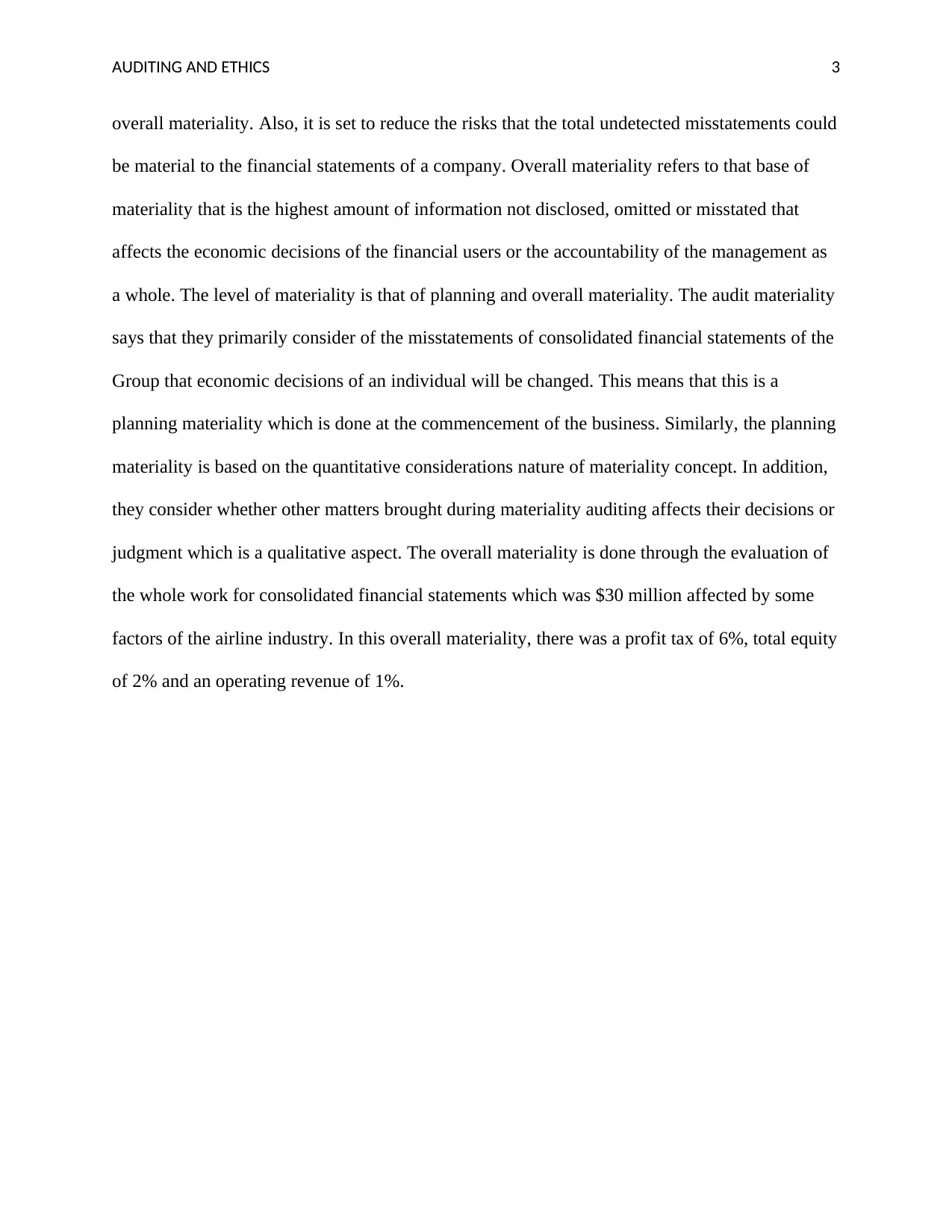
AUDITING AND ETHICS 3
overall materiality. Also, it is set to reduce the risks that the total undetected misstatements could
be material to the financial statements of a company. Overall materiality refers to that base of
materiality that is the highest amount of information not disclosed, omitted or misstated that
affects the economic decisions of the financial users or the accountability of the management as
a whole. The level of materiality is that of planning and overall materiality. The audit materiality
says that they primarily consider of the misstatements of consolidated financial statements of the
Group that economic decisions of an individual will be changed. This means that this is a
planning materiality which is done at the commencement of the business. Similarly, the planning
materiality is based on the quantitative considerations nature of materiality concept. In addition,
they consider whether other matters brought during materiality auditing affects their decisions or
judgment which is a qualitative aspect. The overall materiality is done through the evaluation of
the whole work for consolidated financial statements which was $30 million affected by some
factors of the airline industry. In this overall materiality, there was a profit tax of 6%, total equity
of 2% and an operating revenue of 1%.
overall materiality. Also, it is set to reduce the risks that the total undetected misstatements could
be material to the financial statements of a company. Overall materiality refers to that base of
materiality that is the highest amount of information not disclosed, omitted or misstated that
affects the economic decisions of the financial users or the accountability of the management as
a whole. The level of materiality is that of planning and overall materiality. The audit materiality
says that they primarily consider of the misstatements of consolidated financial statements of the
Group that economic decisions of an individual will be changed. This means that this is a
planning materiality which is done at the commencement of the business. Similarly, the planning
materiality is based on the quantitative considerations nature of materiality concept. In addition,
they consider whether other matters brought during materiality auditing affects their decisions or
judgment which is a qualitative aspect. The overall materiality is done through the evaluation of
the whole work for consolidated financial statements which was $30 million affected by some
factors of the airline industry. In this overall materiality, there was a profit tax of 6%, total equity
of 2% and an operating revenue of 1%.
⊘ This is a preview!⊘
Do you want full access?
Subscribe today to unlock all pages.

Trusted by 1+ million students worldwide

AUDITING AND ETHICS 4
Section 2
Income statement of AIZ Company preliminarily analytical review 2014-2017 in million
terms.
A company’s revenue is the income that a company earns through its activities from the
sale of goods to their customers. The AIZ Company revenue increased from the year 2014-2016
and decreased in the year 2017. In 2014-2015 it increased from 4663 to 4925. In the year 2016, it
increased from 4925 in 2015 to 5231 (Carter, & Dawson, 2017). The revenue decreased to 5109
in the year 2017compared to the year 2016.
Operating expenses of a company are the costs that a company accrues through its activities
recorded in the income statement. These expenses of AIZ Company have been increasing over
time from 2014-2017. From the 2014-2015 the total operating expenses increased from 3184-
3413. Similarly, there was an increase in 2015-2016 from 3141-3711. Finally, the aggregate
expenses increased slightly from the year 2016-2017 from 3711-3781.
Operating income of a company is a measure of the amount of profit a firm gains after carrying
out its operations and deducting the operating expenses. The AIZ Company operating income
have been increasing since the year 2014-2016 but decreased in 2017. In 2014-2015 there was an
increment from 358-423. In the year 2015-2016, 423-674 (Carter, & Dawson, 2017). However,
the operating income decreased from 674-501 which was not good for the business as the
number of profit reduced.
Net income of a firm is that final profit or loss realized by a business after all expenses have been
deducted. AIZ Corporation has only earned net income profits over the years but a decrease in
2017. In the year 2014-2015, the net profit moved from 262-327. While in the year 2015-2016 it
Section 2
Income statement of AIZ Company preliminarily analytical review 2014-2017 in million
terms.
A company’s revenue is the income that a company earns through its activities from the
sale of goods to their customers. The AIZ Company revenue increased from the year 2014-2016
and decreased in the year 2017. In 2014-2015 it increased from 4663 to 4925. In the year 2016, it
increased from 4925 in 2015 to 5231 (Carter, & Dawson, 2017). The revenue decreased to 5109
in the year 2017compared to the year 2016.
Operating expenses of a company are the costs that a company accrues through its activities
recorded in the income statement. These expenses of AIZ Company have been increasing over
time from 2014-2017. From the 2014-2015 the total operating expenses increased from 3184-
3413. Similarly, there was an increase in 2015-2016 from 3141-3711. Finally, the aggregate
expenses increased slightly from the year 2016-2017 from 3711-3781.
Operating income of a company is a measure of the amount of profit a firm gains after carrying
out its operations and deducting the operating expenses. The AIZ Company operating income
have been increasing since the year 2014-2016 but decreased in 2017. In 2014-2015 there was an
increment from 358-423. In the year 2015-2016, 423-674 (Carter, & Dawson, 2017). However,
the operating income decreased from 674-501 which was not good for the business as the
number of profit reduced.
Net income of a firm is that final profit or loss realized by a business after all expenses have been
deducted. AIZ Corporation has only earned net income profits over the years but a decrease in
2017. In the year 2014-2015, the net profit moved from 262-327. While in the year 2015-2016 it
Paraphrase This Document
Need a fresh take? Get an instant paraphrase of this document with our AI Paraphraser
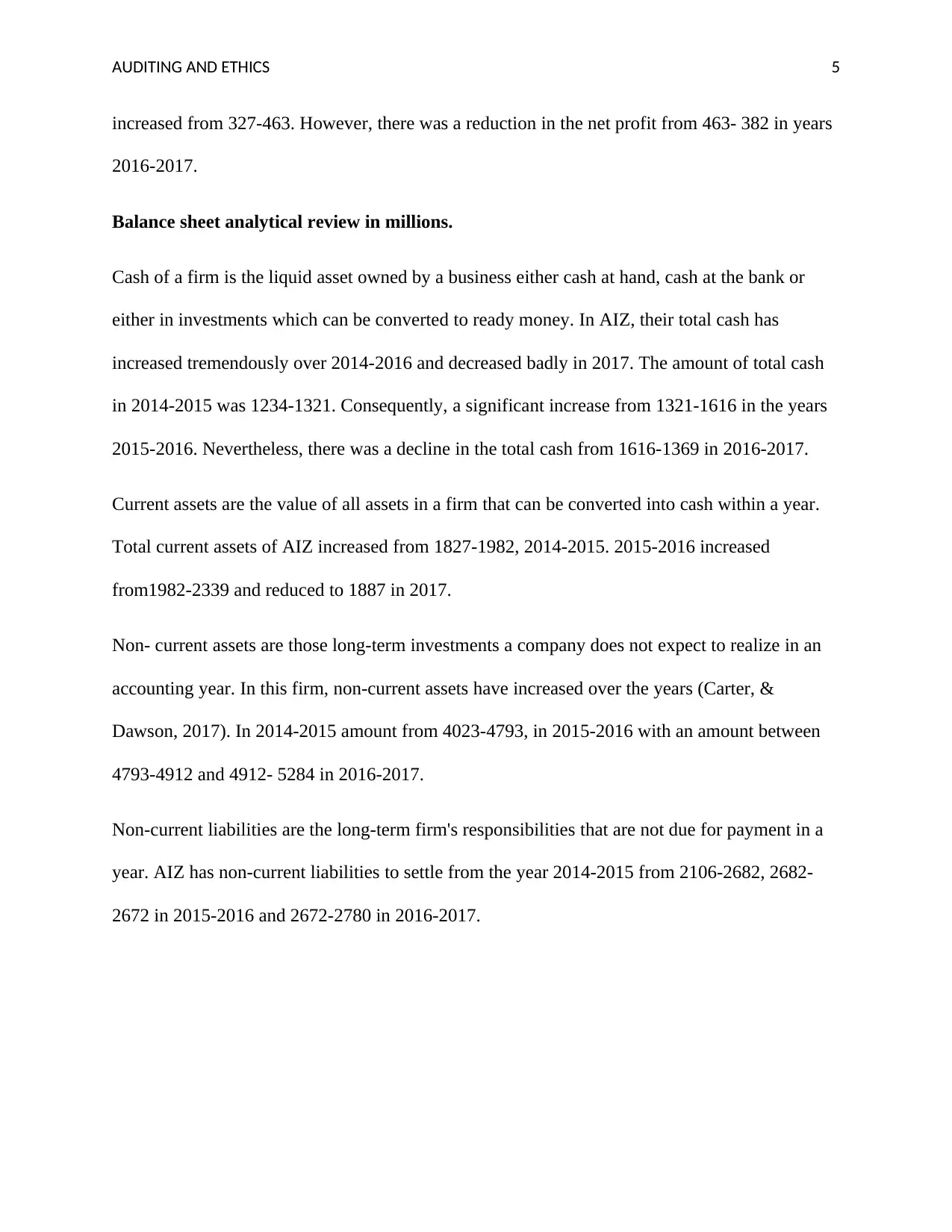
AUDITING AND ETHICS 5
increased from 327-463. However, there was a reduction in the net profit from 463- 382 in years
2016-2017.
Balance sheet analytical review in millions.
Cash of a firm is the liquid asset owned by a business either cash at hand, cash at the bank or
either in investments which can be converted to ready money. In AIZ, their total cash has
increased tremendously over 2014-2016 and decreased badly in 2017. The amount of total cash
in 2014-2015 was 1234-1321. Consequently, a significant increase from 1321-1616 in the years
2015-2016. Nevertheless, there was a decline in the total cash from 1616-1369 in 2016-2017.
Current assets are the value of all assets in a firm that can be converted into cash within a year.
Total current assets of AIZ increased from 1827-1982, 2014-2015. 2015-2016 increased
from1982-2339 and reduced to 1887 in 2017.
Non- current assets are those long-term investments a company does not expect to realize in an
accounting year. In this firm, non-current assets have increased over the years (Carter, &
Dawson, 2017). In 2014-2015 amount from 4023-4793, in 2015-2016 with an amount between
4793-4912 and 4912- 5284 in 2016-2017.
Non-current liabilities are the long-term firm's responsibilities that are not due for payment in a
year. AIZ has non-current liabilities to settle from the year 2014-2015 from 2106-2682, 2682-
2672 in 2015-2016 and 2672-2780 in 2016-2017.
increased from 327-463. However, there was a reduction in the net profit from 463- 382 in years
2016-2017.
Balance sheet analytical review in millions.
Cash of a firm is the liquid asset owned by a business either cash at hand, cash at the bank or
either in investments which can be converted to ready money. In AIZ, their total cash has
increased tremendously over 2014-2016 and decreased badly in 2017. The amount of total cash
in 2014-2015 was 1234-1321. Consequently, a significant increase from 1321-1616 in the years
2015-2016. Nevertheless, there was a decline in the total cash from 1616-1369 in 2016-2017.
Current assets are the value of all assets in a firm that can be converted into cash within a year.
Total current assets of AIZ increased from 1827-1982, 2014-2015. 2015-2016 increased
from1982-2339 and reduced to 1887 in 2017.
Non- current assets are those long-term investments a company does not expect to realize in an
accounting year. In this firm, non-current assets have increased over the years (Carter, &
Dawson, 2017). In 2014-2015 amount from 4023-4793, in 2015-2016 with an amount between
4793-4912 and 4912- 5284 in 2016-2017.
Non-current liabilities are the long-term firm's responsibilities that are not due for payment in a
year. AIZ has non-current liabilities to settle from the year 2014-2015 from 2106-2682, 2682-
2672 in 2015-2016 and 2672-2780 in 2016-2017.

AUDITING AND ETHICS 6
Trend and risk areas for audit
The trend in revenue from 2014-2016 is increment and a decrease in 2017. The decrease
in revenue this means that either there were changes in demand and supply or tastes and
preferences of the consumers or economy fluctuations which reduced the number of customers
traveling. Operating expenses should not be so high and operating income should not decrease at
any year to avoid failure of the business. Net profit should not decline as well as it was cash in
2017 for the smooth running of the firm. Current asset reduced in 2017 meaning that the amount
to convert to cash in short-term lowered in 2017. The company should check on its non- current
liabilities to reduce its obligations for the better profitability of the business. Management
assertions are those claims made by members of a company regarding certain aspects. Therefore,
the auditors have to validate the financial statements to rely on them on matters of the business.
Some of the relevant management assertions revenue recognition and segmental information,
expenses, cash and cash equivalents, investment in other entities, property, plant and equipment,
trade and other receivables, earnings per share, inventories, taxation (Carter, & Dawson, 2017).
Audit procedure for revenues includes reviewing a contract with customers to ensure that all
revenues and expenses are recorded in accuracy using analytical procedures. Also, for cash and
cash equivalents you use bank reconciliation and bank confirmations, type of bank accounts for
entries. Audit procedures for trade and other receivables you confirm the receivables in the
general ledger, calculate the total, investigate reconciling items. For inventories include test the
inventory count, observe physical inventory count and reconcile inventory count in the general
ledger. For the audit investments then develop audit objectives and procedures for investment
then design to appropriate investment assertions.
Trend and risk areas for audit
The trend in revenue from 2014-2016 is increment and a decrease in 2017. The decrease
in revenue this means that either there were changes in demand and supply or tastes and
preferences of the consumers or economy fluctuations which reduced the number of customers
traveling. Operating expenses should not be so high and operating income should not decrease at
any year to avoid failure of the business. Net profit should not decline as well as it was cash in
2017 for the smooth running of the firm. Current asset reduced in 2017 meaning that the amount
to convert to cash in short-term lowered in 2017. The company should check on its non- current
liabilities to reduce its obligations for the better profitability of the business. Management
assertions are those claims made by members of a company regarding certain aspects. Therefore,
the auditors have to validate the financial statements to rely on them on matters of the business.
Some of the relevant management assertions revenue recognition and segmental information,
expenses, cash and cash equivalents, investment in other entities, property, plant and equipment,
trade and other receivables, earnings per share, inventories, taxation (Carter, & Dawson, 2017).
Audit procedure for revenues includes reviewing a contract with customers to ensure that all
revenues and expenses are recorded in accuracy using analytical procedures. Also, for cash and
cash equivalents you use bank reconciliation and bank confirmations, type of bank accounts for
entries. Audit procedures for trade and other receivables you confirm the receivables in the
general ledger, calculate the total, investigate reconciling items. For inventories include test the
inventory count, observe physical inventory count and reconcile inventory count in the general
ledger. For the audit investments then develop audit objectives and procedures for investment
then design to appropriate investment assertions.
⊘ This is a preview!⊘
Do you want full access?
Subscribe today to unlock all pages.

Trusted by 1+ million students worldwide
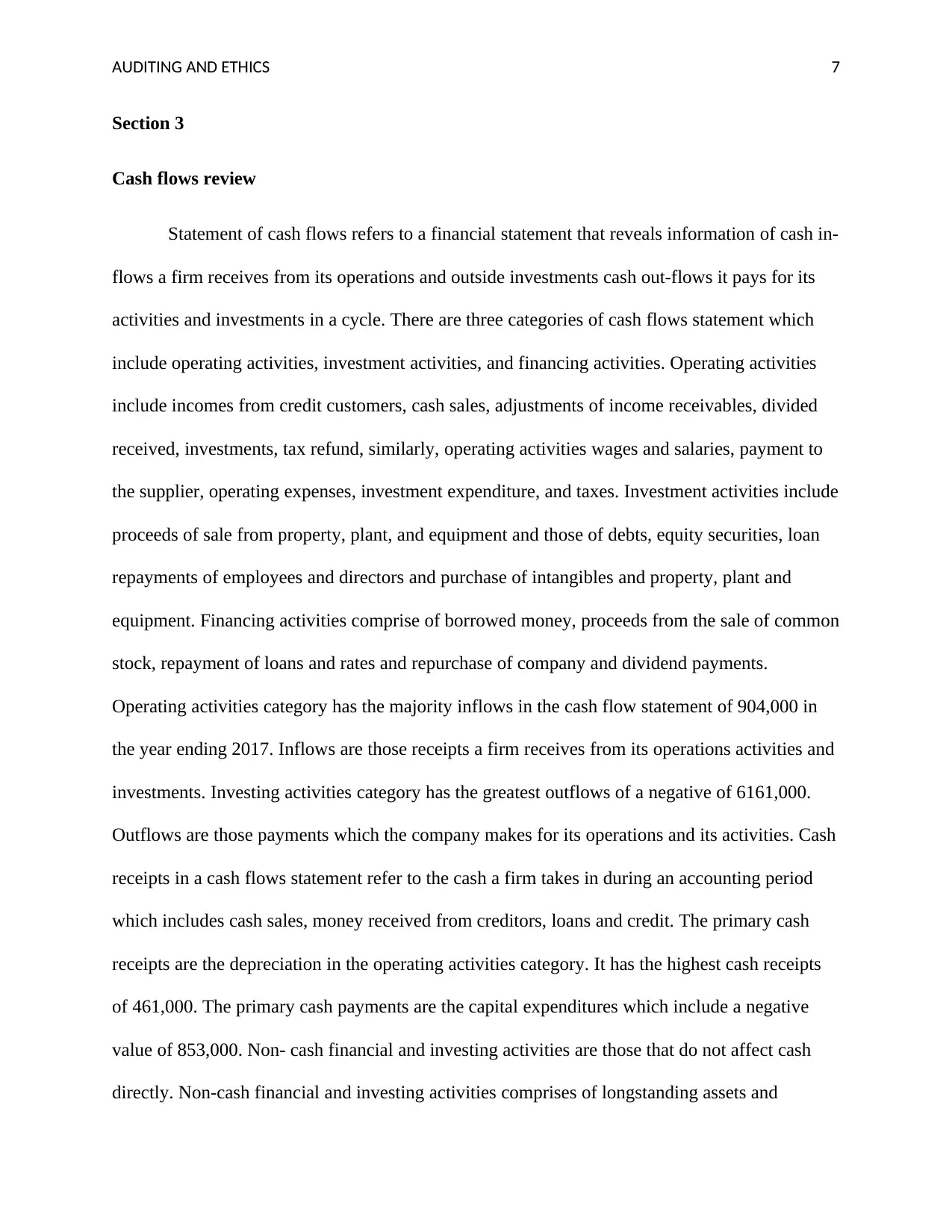
AUDITING AND ETHICS 7
Section 3
Cash flows review
Statement of cash flows refers to a financial statement that reveals information of cash in-
flows a firm receives from its operations and outside investments cash out-flows it pays for its
activities and investments in a cycle. There are three categories of cash flows statement which
include operating activities, investment activities, and financing activities. Operating activities
include incomes from credit customers, cash sales, adjustments of income receivables, divided
received, investments, tax refund, similarly, operating activities wages and salaries, payment to
the supplier, operating expenses, investment expenditure, and taxes. Investment activities include
proceeds of sale from property, plant, and equipment and those of debts, equity securities, loan
repayments of employees and directors and purchase of intangibles and property, plant and
equipment. Financing activities comprise of borrowed money, proceeds from the sale of common
stock, repayment of loans and rates and repurchase of company and dividend payments.
Operating activities category has the majority inflows in the cash flow statement of 904,000 in
the year ending 2017. Inflows are those receipts a firm receives from its operations activities and
investments. Investing activities category has the greatest outflows of a negative of 6161,000.
Outflows are those payments which the company makes for its operations and its activities. Cash
receipts in a cash flows statement refer to the cash a firm takes in during an accounting period
which includes cash sales, money received from creditors, loans and credit. The primary cash
receipts are the depreciation in the operating activities category. It has the highest cash receipts
of 461,000. The primary cash payments are the capital expenditures which include a negative
value of 853,000. Non- cash financial and investing activities are those that do not affect cash
directly. Non-cash financial and investing activities comprises of longstanding assets and
Section 3
Cash flows review
Statement of cash flows refers to a financial statement that reveals information of cash in-
flows a firm receives from its operations and outside investments cash out-flows it pays for its
activities and investments in a cycle. There are three categories of cash flows statement which
include operating activities, investment activities, and financing activities. Operating activities
include incomes from credit customers, cash sales, adjustments of income receivables, divided
received, investments, tax refund, similarly, operating activities wages and salaries, payment to
the supplier, operating expenses, investment expenditure, and taxes. Investment activities include
proceeds of sale from property, plant, and equipment and those of debts, equity securities, loan
repayments of employees and directors and purchase of intangibles and property, plant and
equipment. Financing activities comprise of borrowed money, proceeds from the sale of common
stock, repayment of loans and rates and repurchase of company and dividend payments.
Operating activities category has the majority inflows in the cash flow statement of 904,000 in
the year ending 2017. Inflows are those receipts a firm receives from its operations activities and
investments. Investing activities category has the greatest outflows of a negative of 6161,000.
Outflows are those payments which the company makes for its operations and its activities. Cash
receipts in a cash flows statement refer to the cash a firm takes in during an accounting period
which includes cash sales, money received from creditors, loans and credit. The primary cash
receipts are the depreciation in the operating activities category. It has the highest cash receipts
of 461,000. The primary cash payments are the capital expenditures which include a negative
value of 853,000. Non- cash financial and investing activities are those that do not affect cash
directly. Non-cash financial and investing activities comprises of longstanding assets and
Paraphrase This Document
Need a fresh take? Get an instant paraphrase of this document with our AI Paraphraser
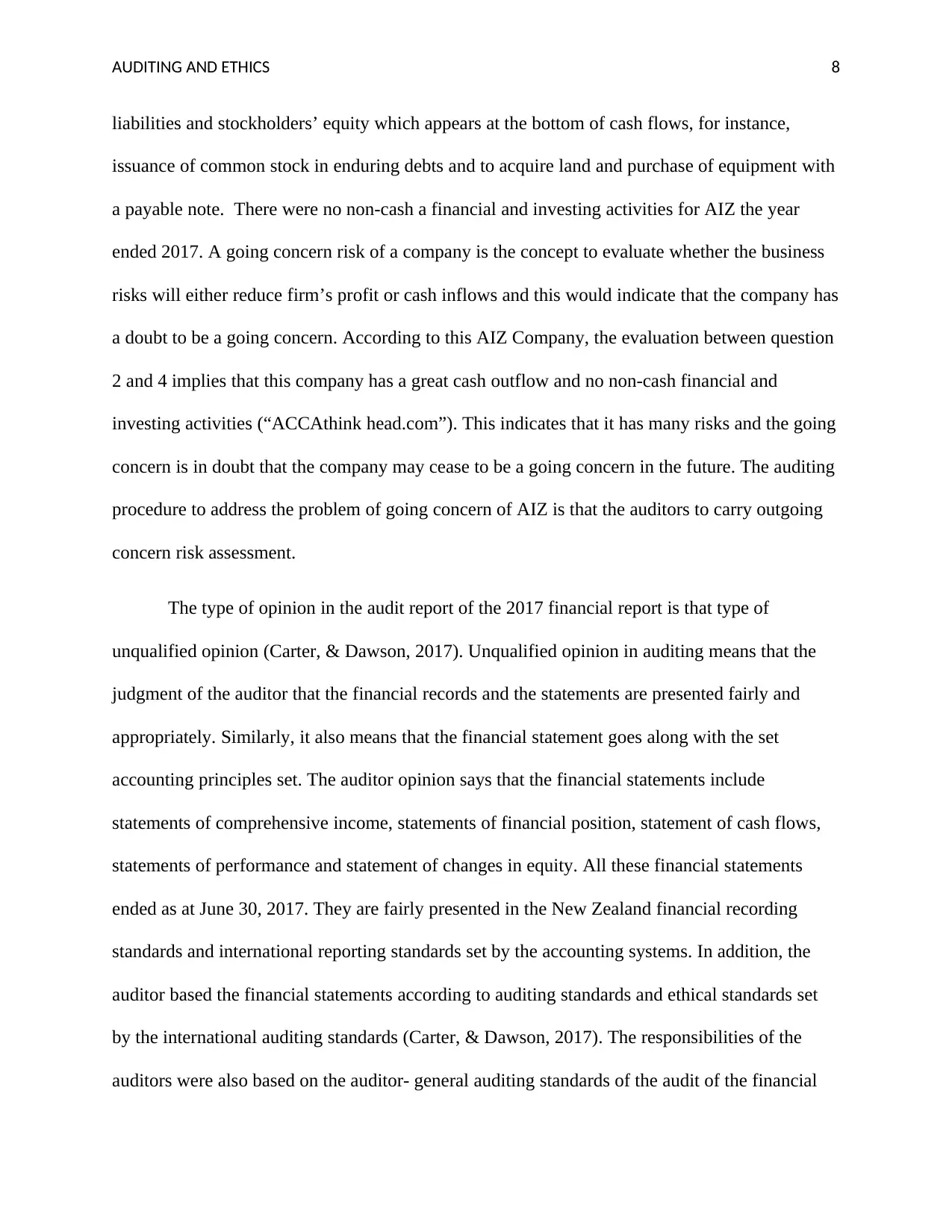
AUDITING AND ETHICS 8
liabilities and stockholders’ equity which appears at the bottom of cash flows, for instance,
issuance of common stock in enduring debts and to acquire land and purchase of equipment with
a payable note. There were no non-cash a financial and investing activities for AIZ the year
ended 2017. A going concern risk of a company is the concept to evaluate whether the business
risks will either reduce firm’s profit or cash inflows and this would indicate that the company has
a doubt to be a going concern. According to this AIZ Company, the evaluation between question
2 and 4 implies that this company has a great cash outflow and no non-cash financial and
investing activities (“ACCAthink head.com”). This indicates that it has many risks and the going
concern is in doubt that the company may cease to be a going concern in the future. The auditing
procedure to address the problem of going concern of AIZ is that the auditors to carry outgoing
concern risk assessment.
The type of opinion in the audit report of the 2017 financial report is that type of
unqualified opinion (Carter, & Dawson, 2017). Unqualified opinion in auditing means that the
judgment of the auditor that the financial records and the statements are presented fairly and
appropriately. Similarly, it also means that the financial statement goes along with the set
accounting principles set. The auditor opinion says that the financial statements include
statements of comprehensive income, statements of financial position, statement of cash flows,
statements of performance and statement of changes in equity. All these financial statements
ended as at June 30, 2017. They are fairly presented in the New Zealand financial recording
standards and international reporting standards set by the accounting systems. In addition, the
auditor based the financial statements according to auditing standards and ethical standards set
by the international auditing standards (Carter, & Dawson, 2017). The responsibilities of the
auditors were also based on the auditor- general auditing standards of the audit of the financial
liabilities and stockholders’ equity which appears at the bottom of cash flows, for instance,
issuance of common stock in enduring debts and to acquire land and purchase of equipment with
a payable note. There were no non-cash a financial and investing activities for AIZ the year
ended 2017. A going concern risk of a company is the concept to evaluate whether the business
risks will either reduce firm’s profit or cash inflows and this would indicate that the company has
a doubt to be a going concern. According to this AIZ Company, the evaluation between question
2 and 4 implies that this company has a great cash outflow and no non-cash financial and
investing activities (“ACCAthink head.com”). This indicates that it has many risks and the going
concern is in doubt that the company may cease to be a going concern in the future. The auditing
procedure to address the problem of going concern of AIZ is that the auditors to carry outgoing
concern risk assessment.
The type of opinion in the audit report of the 2017 financial report is that type of
unqualified opinion (Carter, & Dawson, 2017). Unqualified opinion in auditing means that the
judgment of the auditor that the financial records and the statements are presented fairly and
appropriately. Similarly, it also means that the financial statement goes along with the set
accounting principles set. The auditor opinion says that the financial statements include
statements of comprehensive income, statements of financial position, statement of cash flows,
statements of performance and statement of changes in equity. All these financial statements
ended as at June 30, 2017. They are fairly presented in the New Zealand financial recording
standards and international reporting standards set by the accounting systems. In addition, the
auditor based the financial statements according to auditing standards and ethical standards set
by the international auditing standards (Carter, & Dawson, 2017). The responsibilities of the
auditors were also based on the auditor- general auditing standards of the audit of the financial
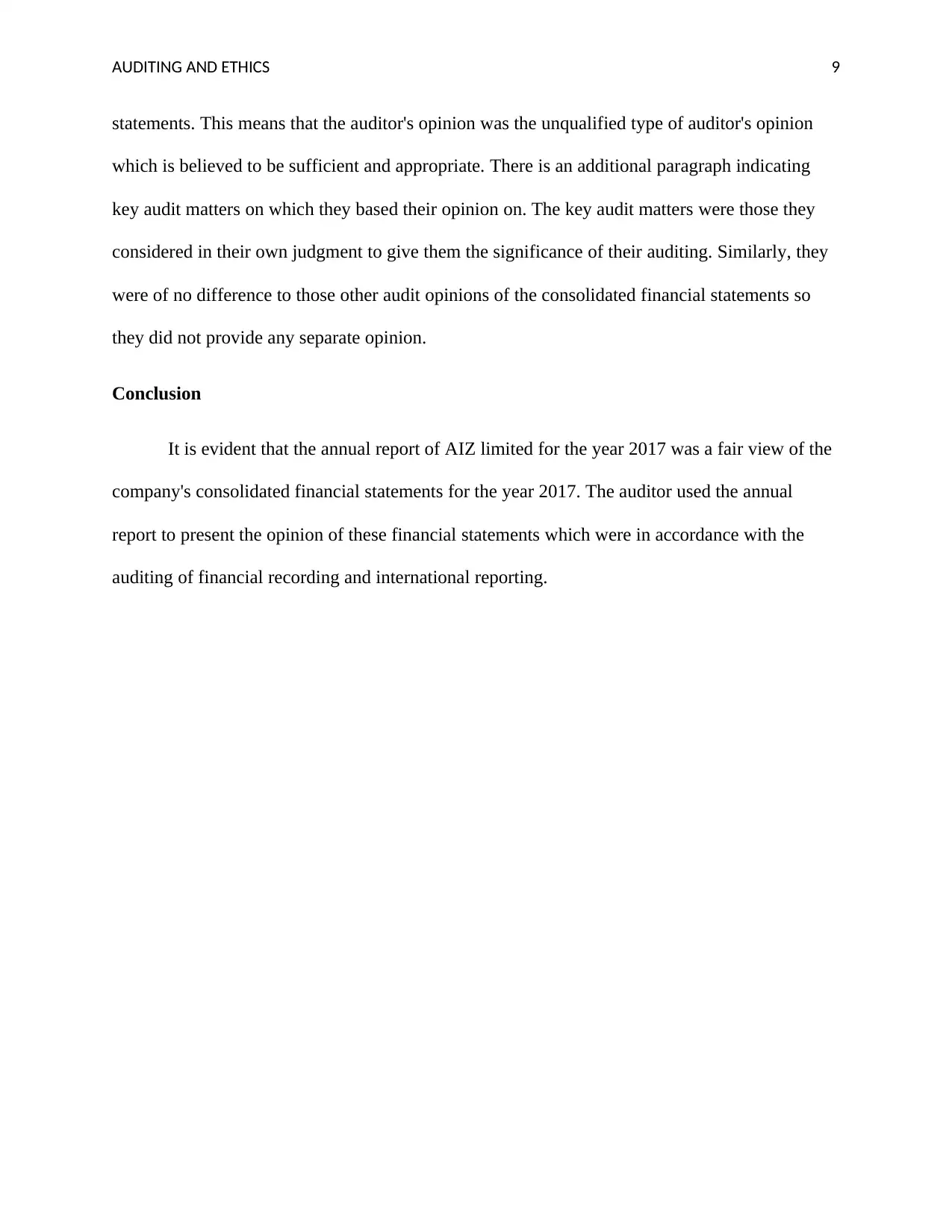
AUDITING AND ETHICS 9
statements. This means that the auditor's opinion was the unqualified type of auditor's opinion
which is believed to be sufficient and appropriate. There is an additional paragraph indicating
key audit matters on which they based their opinion on. The key audit matters were those they
considered in their own judgment to give them the significance of their auditing. Similarly, they
were of no difference to those other audit opinions of the consolidated financial statements so
they did not provide any separate opinion.
Conclusion
It is evident that the annual report of AIZ limited for the year 2017 was a fair view of the
company's consolidated financial statements for the year 2017. The auditor used the annual
report to present the opinion of these financial statements which were in accordance with the
auditing of financial recording and international reporting.
statements. This means that the auditor's opinion was the unqualified type of auditor's opinion
which is believed to be sufficient and appropriate. There is an additional paragraph indicating
key audit matters on which they based their opinion on. The key audit matters were those they
considered in their own judgment to give them the significance of their auditing. Similarly, they
were of no difference to those other audit opinions of the consolidated financial statements so
they did not provide any separate opinion.
Conclusion
It is evident that the annual report of AIZ limited for the year 2017 was a fair view of the
company's consolidated financial statements for the year 2017. The auditor used the annual
report to present the opinion of these financial statements which were in accordance with the
auditing of financial recording and international reporting.
⊘ This is a preview!⊘
Do you want full access?
Subscribe today to unlock all pages.

Trusted by 1+ million students worldwide
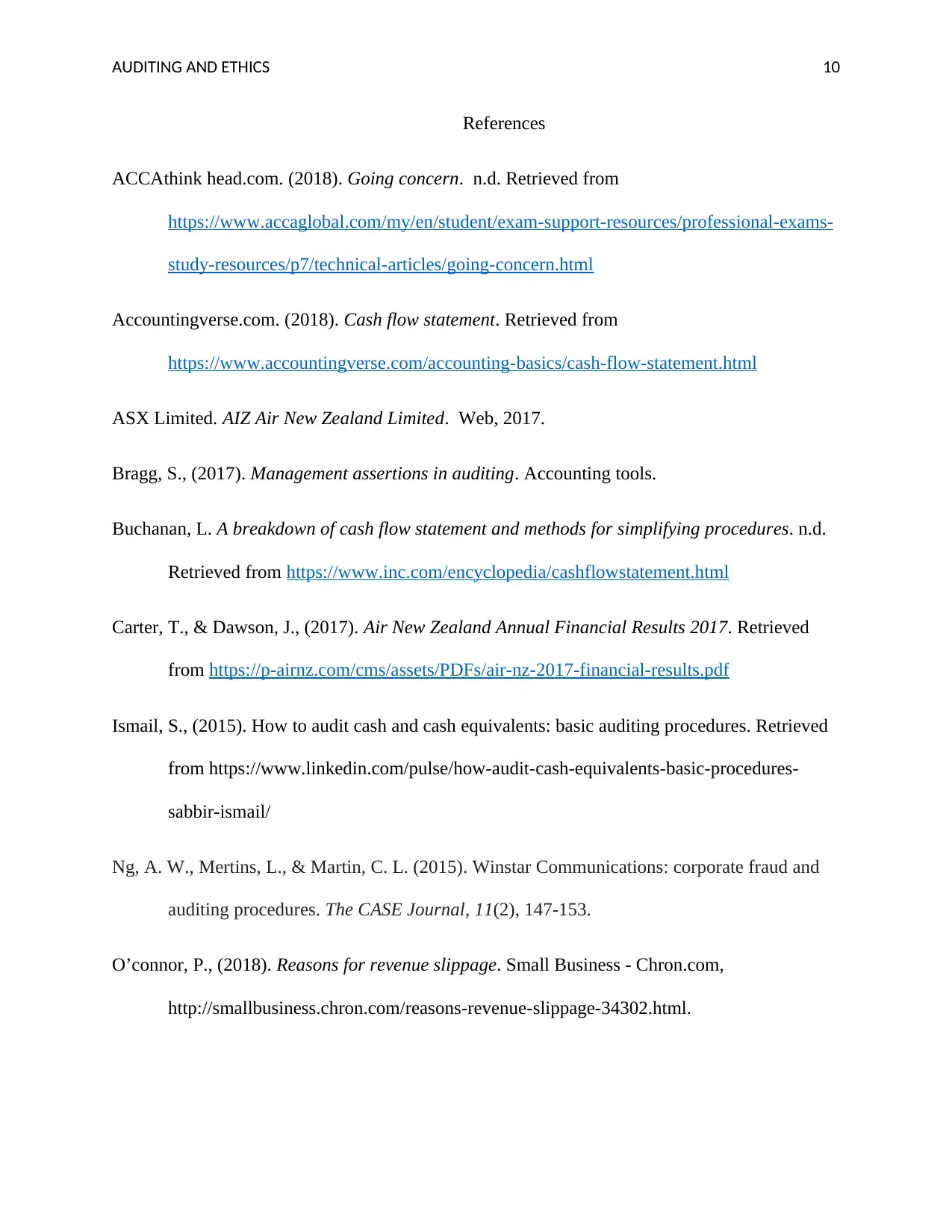
AUDITING AND ETHICS 10
References
ACCAthink head.com. (2018). Going concern. n.d. Retrieved from
https://www.accaglobal.com/my/en/student/exam-support-resources/professional-exams-
study-resources/p7/technical-articles/going-concern.html
Accountingverse.com. (2018). Cash flow statement. Retrieved from
https://www.accountingverse.com/accounting-basics/cash-flow-statement.html
ASX Limited. AIZ Air New Zealand Limited. Web, 2017.
Bragg, S., (2017). Management assertions in auditing. Accounting tools.
Buchanan, L. A breakdown of cash flow statement and methods for simplifying procedures. n.d.
Retrieved from https://www.inc.com/encyclopedia/cashflowstatement.html
Carter, T., & Dawson, J., (2017). Air New Zealand Annual Financial Results 2017. Retrieved
from https://p-airnz.com/cms/assets/PDFs/air-nz-2017-financial-results.pdf
Ismail, S., (2015). How to audit cash and cash equivalents: basic auditing procedures. Retrieved
from https://www.linkedin.com/pulse/how-audit-cash-equivalents-basic-procedures-
sabbir-ismail/
Ng, A. W., Mertins, L., & Martin, C. L. (2015). Winstar Communications: corporate fraud and
auditing procedures. The CASE Journal, 11(2), 147-153.
O’connor, P., (2018). Reasons for revenue slippage. Small Business - Chron.com,
http://smallbusiness.chron.com/reasons-revenue-slippage-34302.html.
References
ACCAthink head.com. (2018). Going concern. n.d. Retrieved from
https://www.accaglobal.com/my/en/student/exam-support-resources/professional-exams-
study-resources/p7/technical-articles/going-concern.html
Accountingverse.com. (2018). Cash flow statement. Retrieved from
https://www.accountingverse.com/accounting-basics/cash-flow-statement.html
ASX Limited. AIZ Air New Zealand Limited. Web, 2017.
Bragg, S., (2017). Management assertions in auditing. Accounting tools.
Buchanan, L. A breakdown of cash flow statement and methods for simplifying procedures. n.d.
Retrieved from https://www.inc.com/encyclopedia/cashflowstatement.html
Carter, T., & Dawson, J., (2017). Air New Zealand Annual Financial Results 2017. Retrieved
from https://p-airnz.com/cms/assets/PDFs/air-nz-2017-financial-results.pdf
Ismail, S., (2015). How to audit cash and cash equivalents: basic auditing procedures. Retrieved
from https://www.linkedin.com/pulse/how-audit-cash-equivalents-basic-procedures-
sabbir-ismail/
Ng, A. W., Mertins, L., & Martin, C. L. (2015). Winstar Communications: corporate fraud and
auditing procedures. The CASE Journal, 11(2), 147-153.
O’connor, P., (2018). Reasons for revenue slippage. Small Business - Chron.com,
http://smallbusiness.chron.com/reasons-revenue-slippage-34302.html.
Paraphrase This Document
Need a fresh take? Get an instant paraphrase of this document with our AI Paraphraser

AUDITING AND ETHICS 11
Perry, L., (2014). Auditing Special Purpose Frameworks: Materiality Levels. Retrieved from
https://www.accountingweb.com/aa/auditing/auditing-special-purpose-frameworks-
materiality-levels
Rogers, H., & Steer, S., (2015). Materiality Guide. NSW ICAC EXHIBIT.
Sharp, L., (2018). Materiality in the audit of financial statement. ICAEW. Retrieved from
https://www.icaew.com/international-accounting-and-auditing/audit-planning/materiality-
in-the-audit-of-financial-statements
Sherman, F., (2018). Types of opinions rendered in accounting. Retrieved from
https://smallbusiness.chron.com/types-audit-opinions-rendered-accounting-61485.html
Weaver.com. (2016). How Auditors Evaluate Going Concern Assumption. Retrieved from
https://weaver.com/blog/how-auditors-evaluate-going-concern-assumption
Perry, L., (2014). Auditing Special Purpose Frameworks: Materiality Levels. Retrieved from
https://www.accountingweb.com/aa/auditing/auditing-special-purpose-frameworks-
materiality-levels
Rogers, H., & Steer, S., (2015). Materiality Guide. NSW ICAC EXHIBIT.
Sharp, L., (2018). Materiality in the audit of financial statement. ICAEW. Retrieved from
https://www.icaew.com/international-accounting-and-auditing/audit-planning/materiality-
in-the-audit-of-financial-statements
Sherman, F., (2018). Types of opinions rendered in accounting. Retrieved from
https://smallbusiness.chron.com/types-audit-opinions-rendered-accounting-61485.html
Weaver.com. (2016). How Auditors Evaluate Going Concern Assumption. Retrieved from
https://weaver.com/blog/how-auditors-evaluate-going-concern-assumption
1 out of 11
Related Documents
Your All-in-One AI-Powered Toolkit for Academic Success.
+13062052269
info@desklib.com
Available 24*7 on WhatsApp / Email
![[object Object]](/_next/static/media/star-bottom.7253800d.svg)
Unlock your academic potential
Copyright © 2020–2025 A2Z Services. All Rights Reserved. Developed and managed by ZUCOL.





